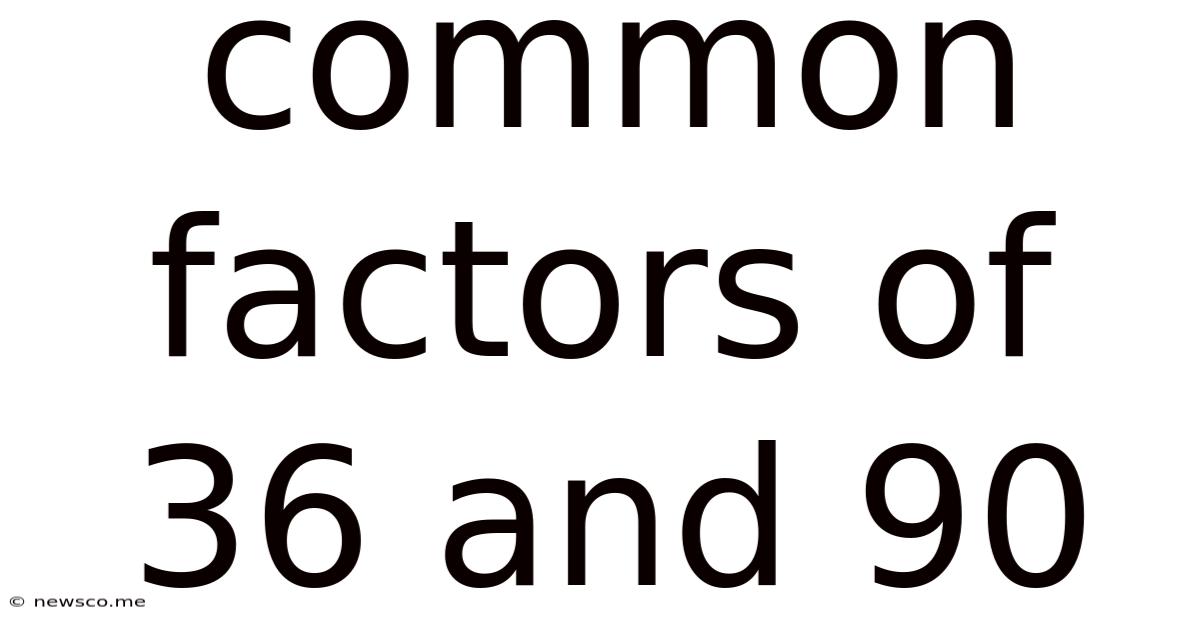Common Factors Of 36 And 90
News Co
May 08, 2025 · 5 min read

Table of Contents
Unveiling the Secrets of Common Factors: A Deep Dive into 36 and 90
Finding the common factors of two numbers might seem like a simple arithmetic task, but understanding the underlying principles reveals a fascinating world of number theory. This exploration delves into the common factors of 36 and 90, demonstrating various methods to identify them, explaining the concepts behind them, and highlighting their significance in mathematics. We'll go beyond simply finding the answer and uncover the broader mathematical context.
Understanding Factors and Common Factors
Before we embark on our journey into the specifics of 36 and 90, let's clarify the fundamental concepts.
Factors: A factor of a number is a whole number that divides the number evenly, leaving no remainder. For instance, the factors of 12 are 1, 2, 3, 4, 6, and 12. Each of these numbers divides 12 without leaving a remainder.
Common Factors: When we consider two or more numbers, a common factor is a number that is a factor of all those numbers. Think of it as the numbers they share.
Method 1: Prime Factorization – The Building Blocks of Numbers
Prime factorization is a powerful technique to find common factors. It involves breaking down a number into its prime factors – numbers divisible only by 1 and themselves.
Prime Factorization of 36:
36 = 2 x 2 x 3 x 3 = 2² x 3²
Prime Factorization of 90:
90 = 2 x 3 x 3 x 5 = 2 x 3² x 5
Now, to find the common factors, we look for the prime factors that appear in both factorizations. Both 36 and 90 have a '2' and two '3's as factors.
Method 2: Listing Factors – A Systematic Approach
This method involves listing all the factors of each number and then identifying the ones they share.
Factors of 36: 1, 2, 3, 4, 6, 9, 12, 18, 36
Factors of 90: 1, 2, 3, 5, 6, 9, 10, 15, 18, 30, 45, 90
By comparing the two lists, we identify the common factors: 1, 2, 3, 6, 9, and 18.
Method 3: Greatest Common Divisor (GCD) – The Highest Common Factor
The greatest common divisor (GCD), also known as the highest common factor (HCF), is the largest number that divides both numbers evenly. Finding the GCD provides a concise way to determine all common factors. There are several methods to calculate the GCD:
- Euclidean Algorithm: This efficient algorithm repeatedly applies the division algorithm until the remainder is zero. The last non-zero remainder is the GCD.
Let's apply the Euclidean algorithm to 36 and 90:
- 90 ÷ 36 = 2 with a remainder of 18
- 36 ÷ 18 = 2 with a remainder of 0
The last non-zero remainder is 18, so the GCD of 36 and 90 is 18.
- Prime Factorization Method: Using the prime factorization from Method 1, we identify the common prime factors and their lowest powers. For 36 (2² x 3²) and 90 (2 x 3² x 5), the common prime factors are 2 and 3². Therefore, the GCD is 2¹ x 3² = 18.
Once we have the GCD (18), we know that all factors of 18 are also common factors of 36 and 90. The factors of 18 are 1, 2, 3, 6, 9, and 18 – confirming our results from the previous methods.
Significance of Common Factors
Understanding common factors has practical applications in various mathematical contexts:
-
Simplification of Fractions: Finding the GCD allows us to simplify fractions to their lowest terms. For example, the fraction 36/90 can be simplified by dividing both the numerator and denominator by their GCD (18), resulting in the equivalent fraction 2/5.
-
Solving Equations: Common factors play a crucial role in solving algebraic equations, particularly when factoring expressions.
-
Geometry and Measurement: Common factors are essential when dealing with problems involving area, volume, and other geometric measurements. For example, finding the dimensions of the largest square tile that can perfectly cover a rectangular floor requires determining the GCD of the floor's length and width.
-
Number Theory: Common factors are fundamental concepts in number theory, contributing to deeper understandings of divisibility, prime numbers, and other advanced mathematical topics.
Beyond the Basics: Exploring Least Common Multiple (LCM)
While we’ve focused on common factors, it's worth briefly mentioning the least common multiple (LCM). The LCM is the smallest number that is a multiple of both numbers. For 36 and 90, the LCM is 180.
The relationship between the GCD and LCM is given by the formula:
GCD(a, b) x LCM(a, b) = a x b
In our case: 18 x 180 = 36 x 90 = 3240
Conclusion: A Deeper Appreciation for Numbers
Determining the common factors of 36 and 90, while seemingly straightforward, opens the door to a richer understanding of fundamental mathematical principles. Through prime factorization, systematic listing, and the calculation of the GCD, we've not only found the common factors (1, 2, 3, 6, 9, and 18) but also explored the broader implications of these concepts in various mathematical fields. The seemingly simple act of finding common factors reveals the intricate beauty and interconnectedness within the realm of numbers. This understanding empowers us to approach more complex mathematical problems with greater confidence and insight. The journey from simple arithmetic to a deeper understanding of number theory is a testament to the power of exploration and critical thinking.
Latest Posts
Related Post
Thank you for visiting our website which covers about Common Factors Of 36 And 90 . We hope the information provided has been useful to you. Feel free to contact us if you have any questions or need further assistance. See you next time and don't miss to bookmark.